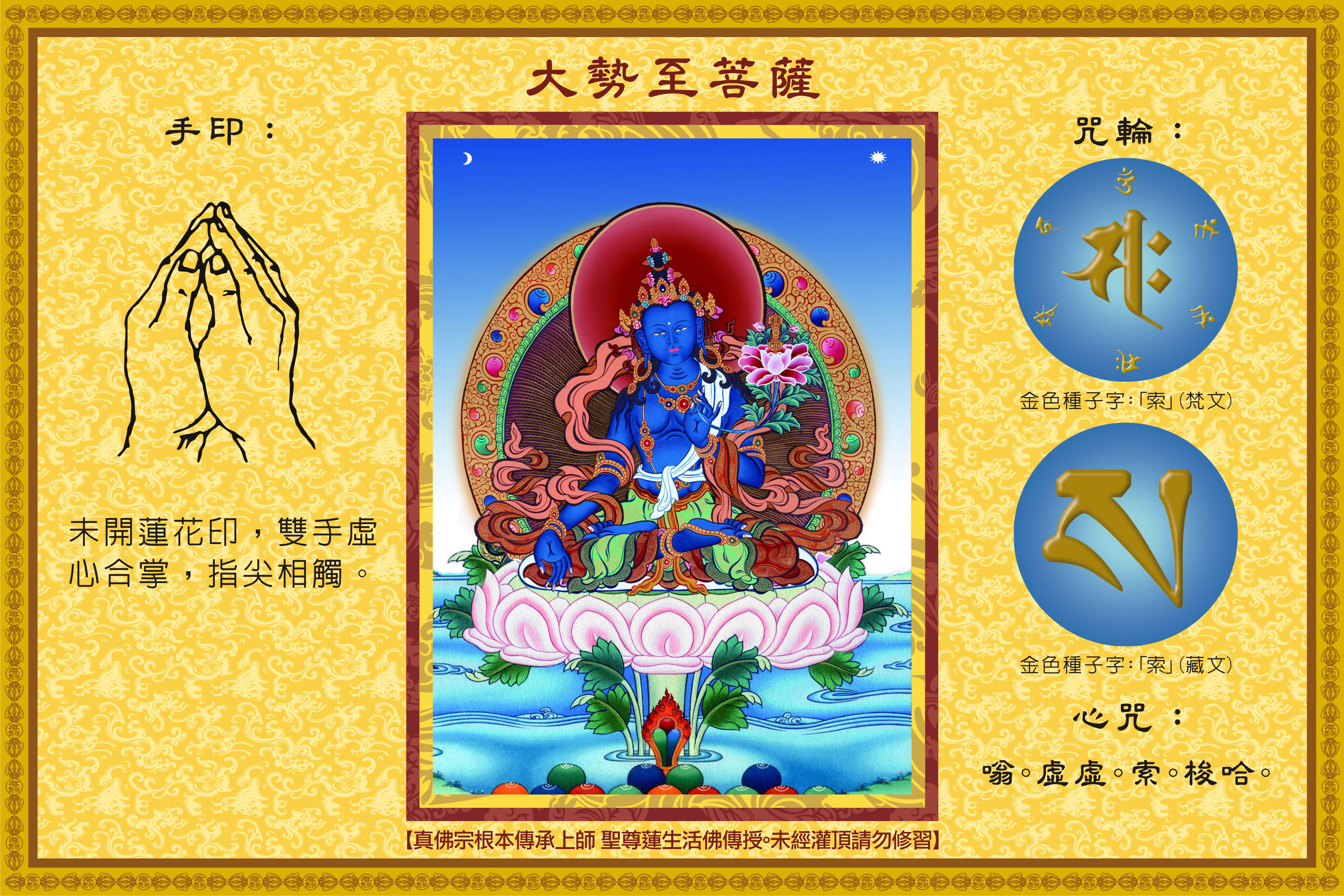首頁 (home) | 佛緣 (fate) | 隨喜 (rejoice) | 功德 (donation)
大勢至菩薩 महास्थामप्राप्त Mahāsthāmaprāpta 勢至菩薩

中文:
大勢至菩薩(梵語:महास्थामप्राप्त, Mahāsthāmaprāpta),又譯為得大勢菩薩,簡稱勢至菩薩。大勢至菩薩是西方極樂世界阿彌陀佛的右脅侍者,八大菩薩之一,因以念佛修行證果,被淨土宗奉為法界初祖,是與觀世音菩薩、文殊菩薩、普賢菩薩、地藏菩薩齊名的大菩薩。據《觀無量壽佛經》記載,「以智慧光普照一切,令離三塗,得無上力,是故號此菩薩名大勢至」;恆念阿彌陀佛,以智慧之光普照一切,使人得到無上力量、威勢自在,接引眾生往生淨土。大勢至菩薩造像多樣,有持貝葉經、持如意者,最多者是手持蓮花,頭戴天冠,天冠中有一寶瓶。
漢傳佛教中,勢至菩薩聖誕是農曆七月十三。淨土宗第十三代祖師印光大師被公認為大勢至菩薩乘願再來。
據《悲華經》卷二稱,久遠過去之「刪提嵐世界」的無諍念王有一千個兒子,長子叫不眴,第二個兒子叫尼摩。無諍念王成佛為阿彌陀佛,不眴太子成為觀世音菩薩。而尼摩則成了大勢至菩薩。阿彌陀佛其左右脅侍就是觀世音菩薩和大勢至菩薩,三位合稱「西方三聖」。其形象據《觀無量壽經》記載,身放紫金色光,法相與裝飾皆同於觀音菩薩。二者的主要區別是:大勢至菩薩頭上的寶冠有寶瓶為標誌,而觀音菩薩頭上的寶冠則以一化佛(阿彌陀佛)為標誌。
按藏傳佛教的一般說法,大勢至菩薩以神通力聞名,號稱「大勇」,現憤怒相時為金剛手菩薩,跟代表大悲的觀世音菩薩和代表大智慧的文殊菩薩一起,為密教最受尊崇的三大菩薩之一。另一說認為金剛手菩薩為普賢菩薩之化身。
大勢至菩薩,根據「觀無量壽經」記載大勢至菩薩以獨特的智能之光遍照世間眾生,使眾生能解脫血光刀兵之災,得無上之力。因此,大勢至菩薩被認為光明智能第一,所到之處天地震動,保護眾生,免受邪魔所害。
大勢至菩薩真言:唵 散髯髯 娑婆訶 / Om sam jam jam (sah) svaha
大勢至菩薩心咒(藏傳):嗡 巴扎 嘿 嗡 巴扎 詹扎 摩訶嚕卡吶吽嘿 / (藏音)HUM VAJRA PHAT OM VAJRA CHANDA MAHA RO KHA NA HUM PHAT / (梵語擬音)Om vajra He Om Vajra Canda Mahā Rusana Hūm He大勢至菩薩,根據「觀無量壽經」記載大勢至菩薩以獨特的智能之光遍照世間眾生,使眾生能解脫血光刀兵之災,得無上之力。因此,大勢至菩薩被認為光明智能第一,所到之處天地震動,保護眾生,免受邪魔所害。
大勢至菩薩真言:唵 散髯髯 娑婆訶 / Om sam jam jam (sah) svaha
大勢至菩薩心咒(藏傳):嗡 巴扎 嘿 嗡 巴扎 詹扎 摩訶嚕卡吶吽嘿 / (藏音)HUM VAJRA PHAT OM VAJRA CHANDA MAHA RO KHA NA HUM PHAT / (梵語擬音)Om vajra He Om Vajra Canda Mahā Rusana Hūm He
English:
Mahāsthāmaprāpta is a bodhisattva mahāsattva who represents the power of wisdom. His name literally means "arrival of the great strength".
Mahāsthāmaprāpta is one of the Eight Great Bodhisattvas in Mahayana Buddhism, along with Mañjuśrī, Samantabhadra, Avalokiteśvara, Ākāśagarbha, Kṣitigarbha, Maitreya and Sarvanivarana-Vishkambhin.
In Chinese Buddhism, Mahasthamaprapta is sometimes portrayed as a woman, Shih Chih, with a likeness similar to Avalokiteśvara. He is also one of the Thirteen Buddhas in the Japanese school of Shingon Buddhism. In Tibetan Buddhism, Mahāsthāmaprāpta is equated with Vajrapani, who is one of his incarnations and was known as the Protector of Gautama Buddha.
Mahāsthāmaprāpta is one of the oldest bodhisattvas and is regarded as powerful, especially in the Pure Land school, where he takes an important role in the Longer Sukhāvatīvyūha Sūtra. He is often depicted in a trinity with Amitābha and Avalokiteśvara (Guanyin), especially in Pure Land Buddhism.
In the Śūraṅgama Sūtra, Mahāsthāmaprāpta tells of how he gained enlightenment through the practice of nianfo, or continuous pure mindfulness of Amitābha, to obtain samādhi. In the Amitayurdhyana Sutra, Mahāsthāmaprāpta is symbolized by the moon while Avalokiteśvara is represented by the sun.
In the Introductory chapter of the Lotus Sutra, Mahāsthāmaprāpta is present among the 80,000 bodhisattva mahāsattvas who assemble on Mount Gṛdhrakūṭa to hear the Buddha's preaching of the Wonderful Dharma of the Lotus Flower Sutra. The Buddha also addresses Mahāsthāmaprāpta in chapter 20 of the Lotus Sutra to tell of the Buddha's past life as the Bodhisattva Sadāparibhūta ("Never Despising"), a monk who was abused and reviled by arrogant monks, nuns, laymen, and laywomen when he paid them respect by saying they would all become Buddhas. The Buddha explains to Mahāsthāmaprāpta how these arrogant people were punished, but are now bodhisattvas present in the assembly on the path to Enlightenment. The Buddha then praises the great strength of the Lotus Sutra thus: “O Mahāsthāmaprāpta, know that this Lotus Sutra will greatly benefit the bodhisattva mahāsattvas and lead them to highest, complete enlightenment. For this reason, after the Tathāgata’s parinirvāṇa the bodhisattva mahāsattvas should always preserve, recite, explain, and copy this sutra.” Mahāsthāmaprāpta is a bodhisattva mahāsattva who represents the power of wisdom. His name literally means "arrival of the great strength".
Mahāsthāmaprāpta is one of the Eight Great Bodhisattvas in Mahayana Buddhism, along with Mañjuśrī, Samantabhadra, Avalokiteśvara, Ākāśagarbha, Kṣitigarbha, Maitreya and Sarvanivarana-Vishkambhin.
In Chinese Buddhism, Mahasthamaprapta is sometimes portrayed as a woman, Shih Chih, with a likeness similar to Avalokiteśvara. He is also one of the Thirteen Buddhas in the Japanese school of Shingon Buddhism. In Tibetan Buddhism, Mahāsthāmaprāpta is equated with Vajrapani, who is one of his incarnations and was known as the Protector of Gautama Buddha.
Mahāsthāmaprāpta is one of the oldest bodhisattvas and is regarded as powerful, especially in the Pure Land school, where he takes an important role in the Longer Sukhāvatīvyūha Sūtra. He is often depicted in a trinity with Amitābha and Avalokiteśvara (Guanyin), especially in Pure Land Buddhism.
In the Śūraṅgama Sūtra, Mahāsthāmaprāpta tells of how he gained enlightenment through the practice of nianfo, or continuous pure mindfulness of Amitābha, to obtain samādhi. In the Amitayurdhyana Sutra, Mahāsthāmaprāpta is symbolized by the moon while Avalokiteśvara is represented by the sun.
In the Introductory chapter of the Lotus Sutra, Mahāsthāmaprāpta is present among the 80,000 bodhisattva mahāsattvas who assemble on Mount Gṛdhrakūṭa to hear the Buddha's preaching of the Wonderful Dharma of the Lotus Flower Sutra. The Buddha also addresses Mahāsthāmaprāpta in chapter 20 of the Lotus Sutra to tell of the Buddha's past life as the Bodhisattva Sadāparibhūta ("Never Despising"), a monk who was abused and reviled by arrogant monks, nuns, laymen, and laywomen when he paid them respect by saying they would all become Buddhas. The Buddha explains to Mahāsthāmaprāpta how these arrogant people were punished, but are now bodhisattvas present in the assembly on the path to Enlightenment. The Buddha then praises the great strength of the Lotus Sutra thus: “O Mahāsthāmaprāpta, know that this Lotus Sutra will greatly benefit the bodhisattva mahāsattvas and lead them to highest, complete enlightenment. For this reason, after the Tathāgata’s parinirvāṇa the bodhisattva mahāsattvas should always preserve, recite, explain, and copy this sutra.”
日本語:
勢至菩薩(せいしぼさつ)、梵名マハースターマプラープタ (महास्थामप्राप्त [mahāsthāmaprāpta])は、仏教における菩薩の一尊。「大勢至菩薩」、「大精進菩薩」、「得大勢菩薩」の別名がある。現在日本では午年の守り本尊、十三仏の一周忌本尊として知られている。三昧耶形は未敷蓮華(ハスの蕾)。種子(種子字)はサク(सः saḥ)。 勢至菩薩(せいしぼさつ)、梵名マハースターマプラープタ (महास्थामप्राप्त [mahāsthāmaprāpta])は、仏教における菩薩の一尊。「大勢至菩薩」、「大精進菩薩」、「得大勢菩薩」の別名がある。現在日本では午年の守り本尊、十三仏の一周忌本尊として知られている。三昧耶形は未敷蓮華(ハスの蕾)。種子(種子字)はサク(सः saḥ)。
阿弥陀三尊の右脇侍。 『観無量寿経』の中には「知恵を持って遍く一切を照らし、三途を離れしめて、無上の力を得せしむ故、大勢至と名づく」とあり、火途・血途・刀途の三途、迷いと戦いの世界の苦しみから知恵を持って救い、その亡者を仏道に引き入れ、正しい行いをさせる菩薩とされる[1]。
薬師如来本願功徳経では、八大菩薩[2]の一尊である。
四国八十八箇所霊場十三仏では第53番札所の須賀山圓明寺で朱印がもらえる。京都十三仏霊場では第9番札所の大内山仁和寺。
COPYRIGHT © Dukkha Buddhism | Donation since 2006